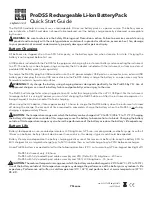
DC Connections
Connect a Red 8 AWG wire to the POS+ lug on the distribution center’s fuse board. Make
sure this lug is torqued properly. In a similar fashion, connect a Black 8 AWG wire to the
NEG- lug on the distribution center’s fuse board.
A battery IS NOT required for converter operation. The battery works in conjunction with
the converter to supply DC power to the RV. A battery is typically only necessary if you do
a lot of dry camping or have slide-outs and/or a leveling system. Deep-cycle batteries are
recommended. They can be either of the Lead-Acid or the AGM type. The Amp hour (Ah)
rating should be shown on the battery; for example, 120A. If you do a lot of dry camping,
we recommend using a deep cycle battery rated at 100 Amp hours or more. The higher the
Amp hour rating, the longer the battery will be able to deliver power when the converter is
not plugged in. If you are plugged into shore power most of the time, a normal deep cycle
battery will work.
When installing batteries, the batteries MUST be the same brand and type (preferably the
same age as well). Adding more batteries will provide longer use of DC appliances when not
on shore power. Due to the additional battery load, the converter’s battery charging
efficiency may be reduced. However, even in normal “Absorption Mode” (13.6 VDC range),
the batteries are being charged, just at a slower rate.
NOTE: The converter will not work without AC input. You may notice that, when a battery
is connected or reconnected to the converter’s output, the onboard fan may energize for a
few seconds. This is normal and is the converter’s circuitry recognizing the battery voltage.
You will notice the same occurrence when the converter is initially energized on Shore
power.
AC Connections
The WF-8855E Converter-Chargers receive power from the power cord on the
opposite end of the enclosure from the DC lugs. The WF-8855E has a standard 15 Amp
plug.
10
Summary of Contents for WF-8855E
Page 11: ...11 Figure 6 ...
Page 12: ...12 Figure 7 ...
Page 13: ...13 ...
Page 14: ...14 ...
Page 15: ...15 ...


































